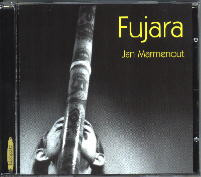
Jan Marmenout
Fujara
Album BE 1998 on Highgate Music label
Electronic, Folk, World and (Ambient, Folk)
During one of my recent travels through the East of Europe, I heard about the existence in Slovakia of a huge (± 1,70 m) overtone-flute, called 'Fujara'. The first time I saw that beautiful flute in Austria and tried to play on it, I was at once fascinated by it's warm deep Archaïc sound. I fell directly in love with it and although I didn't know anything about the traditional way to play it, I set of with a friend to Slovakia, bought one there and started to play on it every day. Later I've met some local musicians playing it for me, and also I listened frequently to some recordings from the Fujara, played in purely traditional style. Although, having a deep respect for tradition, I discovered that this instrument can also be played and used in many other ways. It has a definite 'meditative' quality and also a lot of 'rhythmical' possibilities. Being myself originally a percussionist, I'm appreciating this very much. It's undoubtedly the strangest, biggest and most majestic flute of Europe and maybe it isn't wrong to say it could be our Western equivalent (although much taller, differently shaped and with another playing technique) of the world-known Japanese Shakuhachi. Traditionally it's made totally by hand from deciduous trees (elder tree, maple tree). It's a typical folk instrument and it's native home is a small region in central Slovakia, called Zvolenska country. The fujara belongs to the solo-instruments. It consists of two main-parts; a whistle pipe and an air-pipe and there are only three holes for finger playing. In general it's also beautifully decorated and it can take up to one month to build a good Fujara. With these recordings, I hope to reveal something of the fascinating sound of the Fujara. I also hope that, far from being a traditional fujara-player, I can contribute a bit to the discovery and appreciation of maybe one of the oldest flutes from our Western culture. (Jan) 1. Singing bowls, Spanish Cowbell, Fujara 2. Four double fujara's 3. Fujara, Berimbau, Shruti-box, Rattles, Swedish overtone Flute, Tingsha's 4. Didge 1&2, Shruti-box, Fujara 5. Fujara, Jew's Harp, Bull-roarer, Tube, Frame-drum 6. Fujara, Shruti-box 7. Jew's harp, Udu, Shakers, Fujara, Didge 8. Fujara, Singing Bowl, Bass-drum, Jew's Harp, Triangle, Conga 9. Jew's Harp, Fujara, Singing Bowl, Bass-drum, Voice, Ghost-tube, Nepalese Bell 10. Fujara's, Udu's, Wind-chimes, Jew's Harp, Shakers 11. Two fujara's Credits: All compositions written and all instruments played by Jan Marmenout. Digitally recorded, mixed and mastered at Highgate Music by Ivan Candaele. Basic dubs of tracks 3 and 10 recorded by Philippe de Chaffoy. Produced by Ivan Candaele.
Musicians
 | Jan Marmenout dgdo, tr, BE album by |
Producers
| Ivan Candaele producer |
Album Tracks
| No | Title | Artist | Composer | Duration |
|---|---|---|---|---|
| 1 | Opening II | Jan Marmenout | 6:13 | |
| 2 | Waves | Jan Marmenout | 1:16 | |
| 3 | Fujara | Jan Marmenout | 12:53 | |
| 4 | Lost Valleys | Jan Marmenout | 7:56 | |
| 5 | Riding The Wind | Jan Marmenout | 5:34 | |
| 6 | Coming Home | Jan Marmenout | 8:21 | |
| 7 | Melange Bizarre | Jan Marmenout | 3:42 | |
| 8 | The Gift | Jan Marmenout | 10:49 | |
| 9 | Puja | Jan Marmenout | 4:02 | |
| 10 | Sundance | Jan Marmenout | 4:58 | |
| 11 | Double Fujara | Jan Marmenout | 5:17 |
